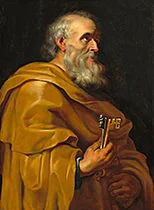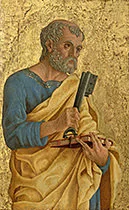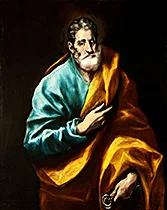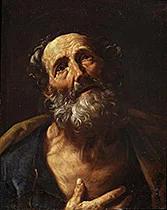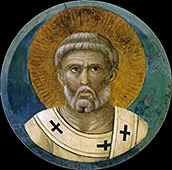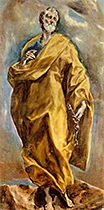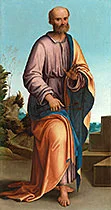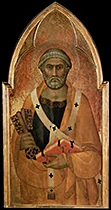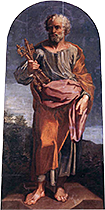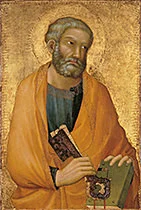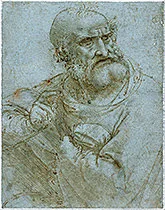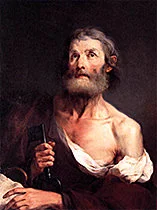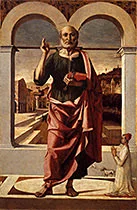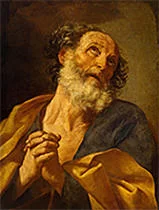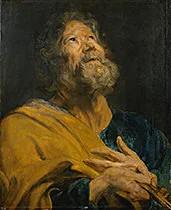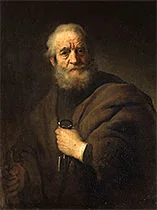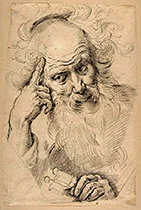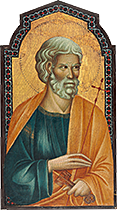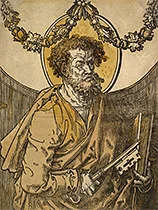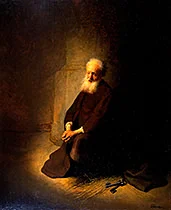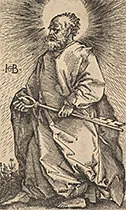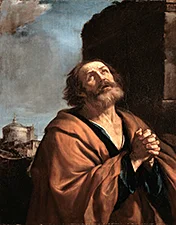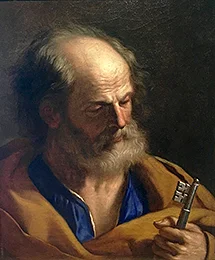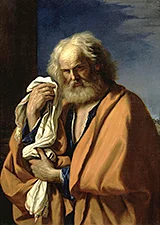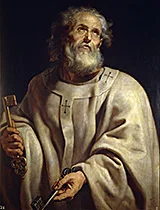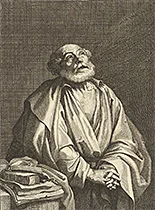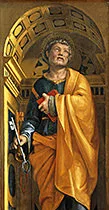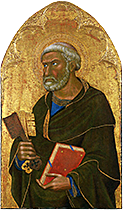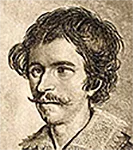The Art World Commemorates Peter
— Album 1 of 17 Photo Albums —
Warren Camp’s presentation of 550 famous “Peter” works of art includes historic paintings, frescoes, stained glass, etchings, sculptures, engravings, and other artwork monuments. They come from the Gothic (1100–1400), High Renaissance, Baroque, Rococo, Neoclassical, and Romantic (1800s) eras.
All are popular works designed and created by celebrated artists, many of whom you’ll likely recognize, including Rembrandt, Raphael, Michelangelo, El Greco, Da Vinci, Masaccio, Huret, Galle, Tissot, Botticelli, Correggio, Dürer, Rubens, and many more. They’ll bring back recollections of your Art History 101 classes and using Janson’s History of Art textbook.
Whether depicting “Cephas,” “Petrus,” “Simon,” “Simeon,” “Simon Bar-Jonah,” “Simon Peter,” “The Rock,” “Peter,” “Apostle Peter,” or “Saint Peter,” the enlarged images of this acclaimed Bible figure come with factual and enlightening details: the artist’s bio; when each work was created; where it can be seen; applicable Bible passages; background and highlights of each work; and photo sources with copyright notices.
To appreciate the impact that Peter had on numerous art-world masters, be sure to click each thumbnail to enlarge it.
• These photo albums complement the Bible-study commentaries Warren has written for “1st and 2nd Peter,” found here.
…
Album 1 (Peter, alone) | Album 2 | Album 3 | Album 4 | Album 5
Album 6 | Album 7 | Album 8 | Album 9 | Album 10 | Album 11
Album 12 | Album 13 | Album 14 | Album 15 | Album 16 | Album 17
Album topics are shown at the [ ⇓ bottom ⇓ ] of each page.
Peter, Alone
Slide 7
Click to enlarge.
Giotto di Bondone
1290 to 1300
fresco painting
Basilica of
St Francis of Assisi
of an Apostle”
Slide 15
Click to enlarge.
Da Vinci — 1493–1495
silver-point pen and ink
- Slide 1. “Saint Peter,” oil on panel, by Peter Paul Rubens, c. 1616–1618
“Saint Peter, portrayed here by Rubens in half-length as a slightly balding, full-bearded patriarch, stands grasping ‘the keys of the kingdom of heaven.’[1] With his deep-set eyes gazing upward to the spiritual realm,… draped in an ocher-colored robe, his body feels strong and powerful, a reminder of his life as a fisherman before joining Jesus’ disciples.
“Images of the twelve apostles were popular during the Catholic Counter Reformation… Series depicting the Twelve proliferated at that time, the most impressive of which was the one that Peter Paul Rubens produced in the early 1610s for the Duke of Lerma, the powerful minister to King Philip III of Spain (now in the Prado).”[2]
In the Scriptures, Peter is mentioned as being among the first apostles; he was neither the eldest of the Twelve nor the first to receive the Messiah’s call (it was Andrew). “The New Testament makes it abundantly clear that Christ is both the foundation (Acts 4:11–12; 1 Corinthians 3:11) and the head (Ephesians 5:23) of the church. It is a mistake to think that here He is giving either of those roles to Peter. There is a sense in which the apostles played a foundational role in the building of the church (Ephesians 2:20), but the role of primacy is reserved for Christ alone, not assigned to Peter.
… Height: 36.25 in. (92 cm), width: 26.5 in. (67.5 cm)
… Photo source, license, attribution, museum details, and image enlargement: National Gallery of Art; the Timken Collection
… The artist’s short biography; his other works of art
… See eight additional Rubens’ oil paintings in our “Peter Masterpieces” albums: Album 4 (5@); #5; 9; and 16.
See the list of Warren’s “Peter Masterpieces” or go to the top of this page or open the next album. - 2. “Saint Peter,” tempera on poplar, by Marco Zoppo, c. 1468
“Italian painter Zoppo (originally Marco di Ruggero) was active in Venice (1455, 1468–73) and associated himself with the most progressive artists in northern Italy during the third quarter of the fifteenth century. He executed further works in Bologna, including a triptych for the Collegio di Spagna, and a number of ‘Madonna Enthroned with Infant and Saints.’ Influenced by Mantegna, Jacopo, and Giovanni Bellini, Zoppo produced paintings in a distinctively harsh and precise style.”[1] This tempera-on-poplar-panel painting is titled “Saint Peter.”
This balding, grey-bearded saint can be identified as Saint Peter. He holds large keys that he’s raised in his right hand, directly above a book, symbolizing the Bible, which states in Matthew 16:19: “I will give you the keys of the kingdom of heaven; whatever you bind on earth will be bound in heaven, and whatever you loose on earth will be loosed in heaven.” Note: “Jesus’ words meant that Peter would have the right to enter the kingdom himself, that he would have general authority symbolized by the possession of the keys, and that preaching the gospel would be the means of opening the kingdom of heaven to all believers and shutting it against unbelievers. The expressions bind and loose were common to Jewish legal phraseology, meaning to declare something forbidden or to declare it allowed.”[2]
See fifteen “Christ Gives Peter the Keys to Heaven” masterpieces in Warren Camp’s Album 4.
… Height: 20 in. (50.6 cm), width: 12 3/8 in. (31.4 cm)
… Photo source, license, attribution, museum details, and image enlargement: National Gallery of Art; the Samuel H. Kress Collection
… The artist’s short biography; his other works of art
Return to “Peter Masterpieces” album’s opening page or to the top of this page or open the next album. - 3. “Apostle Peter,” painted by El Greco, 1610–1614
“Apostle Peter” by El Greco: Jesus proclaimed that Simon was Peter, “the rock,”[1] which is often misinterpreted. “The New Testament makes it abundantly clear that Christ is both the foundation (Acts 4:11–12; 1 Corinthians 3:11) and the head (Ephesians 5:23) of the church. It’s a mistake to think that here He is giving either of those roles to Peter. There is a sense in which the apostles played a foundational role in the building of the church (Ephesians 2:20), but the role of primacy is reserved for Christ alone, not assigned to Peter.
“So, Jesus’ words here are best interpreted as a simple play on words in that a boulder-like truth came from the mouth of one called a small stone. Christ Himself is called the chief cornerstone (1 Peter 2:6–7). The chief cornerstone of any building was that upon which the building was anchored. If Christ declared Himself to be the cornerstone, how could Peter be the rock upon which the church was built? It’s more likely that believers, of which Peter is one, are the stones that make up the church, anchored upon the Cornerstone, ‘and he who believes on Him will by no means be put to shame’ (v. 6).”[2]
This painting is based on the Biblical stories of Saint Peter denying Jesus three times, as shown in Matthew 26, Mark 14, Luke 22, John 13, and John 18.
… Height: 39.7 in. (101 cm), width: 31.8 in. (81 cm)
… Photo source, license, attribution, museum details, and image enlargement: El Greco, public domain, via Wikimedia Commons
… The artist’s short biography; his other works of art
… See seven additional El Greco oil paintings in our “Peter Masterpieces” albums: Album 2; 3 (2@); 9; 13 (2@); and 16.
Return to “Peter Masterpieces” album’s opening page or to the top of this page or open the next album. - 4. “Saint Peter Penitent,” oil on canvas, by Guido Reni, 1634
Guido Reni (1575–1642) presents “Saint Peter Penitent,” chief of the apostles, in this bust-length closeup. Gazing upwards, with his hand on his bare chest, we see and feel Peter’s repentance, following his denial(s) that he knew Christ (Mark 14:66–72). He’d become a popular subject in painting from the time of the Counter-Reformation. This painting resembles Saint Peter being most penitent; see the tear flowing from his right eye. This oil-on-canvas painting records the anguish of St Peter on the night of Christ’s arrest by Roman soldiers when he repents for having denied three times that he knew the Christ.
Contrary to what the Bible documents, people centuries ago believed that Peter was the first pope. Even today, “the Roman Catholic Church sees Peter as the first pope upon whom God had chosen to build His church. But while Peter was central in the early spread of the gospel (part of the meaning behind Matthew 16:18–19), the teaching of Scripture, taken in context, nowhere declares that he was in authority over the other apostles or over the church (having primacy). He was not the first Roman bishop nor the first pope.[1]
This painting is based on the Biblical stories of Saint Peter denying Jesus three times, as shown in Matthew 26, Mark 14, Luke 22, John 13, and John 18.
… Height 24.6 in. (62.5 cm), width: 18.9 in. (48 cm)
… Photo source, license, attribution, museum details, and image enlargement: WikiArt
… The artist’s short biography; his other works of art
… See two additional Guido Reni oil paintings in our “Peter Masterpieces” albums: Album 4 and 16.
Return to “Peter Masterpieces” album’s opening page or to the top of this page or open the next album. - 5. “Saint Peter,” gold on wood panel altarpiece, painted by Cecco di Pietro, c. 1386
“Saint Peter” by Cecco di Pietro: “The Musée du Petit Palais is a museum and art gallery in Avignon, southern France. Cecco di Pietros’s four panels in Avignon present the standing Saints Peter, John the Baptist, Bartholomew, and Nicholas; they probably formed the side panels of an altarpiece, which had in its center the Virgin and Child Enthroned (signed and dated 1386, now in the Portland Art Museum, Portland, Oregon)”[1]
This bearded saint can be identified as Saint Peter who holds large keys in his right hand and a book in his left hand, symbolizing the Bible, which states in Matthew 16:19: “I will give you the keys of the kingdom of heaven; whatever you bind on earth will be bound in heaven, and whatever you loose on earth will be loosed in heaven.” Note: “Jesus’ words meant that Peter would have the right to enter the kingdom himself, that he would have general authority symbolized by the possession of the keys, and that preaching the gospel would be the means of opening the kingdom of heaven to all believers while shutting it against unbelievers. The expressions bind and loose were common to Jewish legal phraseology, meaning to declare something forbidden or to declare it allowed.”[2]
Find a number of Cecco di Pietro’s altarpiece paintings on this WikiPedia page. And, see fifteen “Christ Gives Peter the Keys to Heaven” masterpieces in Warren Camp’s Album 4.
… Height: 36.2 in. (92 cm), width: 11.8 in. (30 cm)
… Photo source, license, attribution, museum details, and image enlargement: public domain, via Web Gallery of Art
… The artist’s short biography; his other works of art
Return to “Peter Masterpieces” album’s opening page or to the top of this page or open the next album. - 6. “Saint Peter,” tempera on lime painting by Carlo Crivelli, 1476
“This stern and commanding figure is Saint Peter by Carlo Crivelli. It comes from a polyptych (a painting, typically an altarpiece, consisting of more than three leaves or panels joined by hinges or folds), which Crivelli painted for the high altar of the church of San Domenico, in Ascoli Piceno, in the Italian Marche. His hooded eyes gaze intently out at us, while his graying beard, tanned face and deeply lined features, painted with Crivelli’s customary exactness, suggest a life of toil in the open air: Peter was a fisherman on the Sea of Galilee before being called by Christ to join him.
“Peter stands on a marble shelf, like a statue, in front of a background of burnished gold which is tooled — patterned with special tools — to look like damask. In a detail typical of Crivelli, his right shoe pokes out over the edge of the marble parapet.”[1]
Contrary to what the Bible documents, people centuries ago believed that Peter was the first pope. Even today, “the Roman Catholic Church sees Peter as the first pope upon whom God had chosen to build His church. But while Peter was central in the early spread of the gospel (part of the meaning behind Matthew 16:18–19), the teaching of Scripture, taken in context, nowhere declares that he was in authority over the other apostles or over the church (having primacy). He was not the first Roman bishop nor the first pope.[2]
… Height: 54.7 in. (139 cm), width: 15.9 in. (40.5 cm)
… Photo source, license, attribution, museum details, and image enlargement: The National Gallery, Trafalgar Square London
… The artist’s short biography; his other works of art
… See two additional Carlo Crivelli paintings in our “Peter Masterpieces” albums: Album 3 and 10.
Return to “Peter Masterpieces” album’s opening page or to the top of this page or open the next album. - 7. “Saint Peter,” fresco roundel painting by Giotto di Bondone, 1290 to 1300
Giotto di Bondone’s “Saint Peter” is a picture in a round format called a “roundel.” The term usually describes a small round element of a larger picture such as an altarpiece, which is a painted or sculpted work of art, placed on, above, or behind the altar in a Christian church.
The majority of portraits that show a model looking out at the viewer imply a conversation. Here in Giotto’s roundel fresco painting, we’re presented with a conversation piece for us viewers to appreciate. Within this roundel’s painted frame is a fresco of a blessed Saint Peter, adorned with a halo. His attentive gaze looks directly into our eyes, as if he was about to tell us something.
The roundel format that Giotto had imposed on Saint Peter makes it resonate with recollections of ancient coins and imagines clipeatae (portraits of ancestors on round shields, in ancient Roman times; more generally, portrait busts in a round format).
… Height: 19.6 in. (50 cm), width: 19.6 in. (50 cm)
… Photo source, license, attribution, museum details, and image enlargement: Giotto, public domain, via Wikimedia Commons
… The artist’s short biography; his other works of art
… See four additional Giotto fresco paintings in our “Peter Masterpieces” albums: Album 2 (2@); 8; and 14.
Return to “Peter Masterpieces” album’s opening page or to the top of this page or open the next album. - 8. “Saint Peter,” tempera on poplar panel, painted by Michele Giambono, c. 1447
“Michele Taddeo di Giovanni Bono, known as Giambono, was an Italian painter. His “Saint Peter” reflected the International Gothic style with a Venetian influence. He designed the mosaics of the ‘Birth of the Virgin’ and ‘Presentation in the Temple.’ His best known paintings are the ‘Man of Sorrows’ and this ‘St Peter.’
“The International Gothic style is characterized by elegant and graceful figures with noble men and women wearing elaborate jewelry and richly embroidered clothes, featuring masses of curled hair and highly complex head pieces. Artwork of the period is typified by the use of light, bright colors, especially gold used in ‘manuscripts and panel paintings, tapestries, and polychromed sculpture.’”[1]
We can identify this bearded saint as Saint Peter who holds a large key in his right hand and a book in his left, symbolizing the Bible, which states in Matthew 16:19: “I will give you the keys of the kingdom of heaven; whatever you bind on earth will be bound in heaven, and whatever you loose on earth will be loosed in heaven.” Note: “Jesus’ words meant that Peter would have the right to enter the kingdom himself, that he would have general authority symbolized by the possession of the keys, and that preaching the gospel would be the means of opening the kingdom of heaven to all believers while shutting it against unbelievers. The expressions bind and loose were common to Jewish legal phraseology, meaning to declare something forbidden or to declare it allowed.”[2]
… Height: 34 1/2 in. (87.7 cm), width: 14 1/8 in. (35.9 cm)
… Photo source, license, attribution, museum details, and image enlargement: National Gallery of Art; the Samuel H. Kress Collection
… The artist’s short biography; his other works of art
Return to “Peter Masterpieces” album’s opening page or to the top of this page or open the next album. - 9. “Saint Peter,” tempera and oil on wood, painted by Fra Carnevale, 1450s
Saint Peter, with halo, appears in Fra Carnevale’s painting as elderly, holding two keys of the kingdom of heaven. See fifteen “Christ Gives Peter the Keys to Heaven” masterpieces in Warren Camp’s Album 4.
“Carnevale’s panels, depicting Saint John the Baptist, the Crucifixion, Saint Peter, and Saint Francis (now in various museums) once belonged to a single altarpiece that was a polyptych (a painting, typically an altarpiece, consisting of more than three leaves or panels joined by hinges or folds) that consisted of ten panels arranged in two registers.”[1]
“Fra Carnevale was an Italian painter of the Quattrocento, active mainly in Urbino. Widely regarded as one of the most enigmatic artists, there are only nine works that can be definitively attributed to Carnevale today… Controversy surrounded the four pieces, ‘Saint John the Baptist,’ ‘The Crucifixion,’ ‘Saint Peter,’ and ‘Saint Francis,’ regarding whether or not they were from the same altarpiece. The examination of the carpentry of the panels undertaken for the exhibition at the Metropolitan Museum demonstrates that, despite discrepancies in the dimensions of the painted surfaces, the four works are, indeed, from a single polyptych.”[2]
… Height: 55.5 in. (141 cm), width: 18.1 in. (46 cm)
… Photo source, license, attribution, museum details, and image enlargement: Fra Carnevale, public domain, via Wikimedia Commons
… The artist’s short biography; his other works of art
Return to “Peter Masterpieces” album’s opening page or to the top of this page or open the next album. - 10. “Saint Peter,” oil-on-canvas painting by El Greco, 1608
This “Saint Peter” is an oil-on-canvas “painting by El Greco, in Toledo, toward the end of his life. It is now in the Monasterio del Escorial near Madrid. It shows the apostle standing atop a mountain, holding a set of keys. The heavy drapery and the disproportion between the head and the body are typical of the artist.”[1] See fifteen “Christ Gives Peter the Keys to Heaven” masterpieces in Warren Camp’s Album 4.
Matthew 16:19 states: “I will give you the keys of the kingdom of heaven; whatever you bind on earth will be bound in heaven, and whatever you loose on earth will be loosed in heaven.” Note: “Jesus’ words meant that Peter would have the right to enter the kingdom himself, that he would have general authority symbolized by the possession of the keys, and that preaching the gospel would be the means of opening the kingdom of heaven to all believers while shutting it against unbelievers. The expressions bind and loose were common to Jewish legal phraseology, meaning to declare something forbidden or to declare it allowed.”[2]
“El Greco, who was born in Crete, found many patrons in Toledo, becoming a wealthy man. He produced several versions of this picture during his long career in Spain. According to Saint Luke’s gospel, Saint Peter denied Jesus on the night before his death, thus fulfilling Christ’s prophecy. When Peter heard the cock crow after his betrayal, he remembered Jesus’s words and ‘went out and wept bitterly.’”[3]
… Height: 81 in. (207 cm), width: 41 in. (105 cm)
… Photo source, license, attribution, museum details, and image enlargement: El Greco, public domain, via Wikimedia Commons
… The artist’s short biography; his other works of art
Return to “Peter Masterpieces” album’s opening page or to the top of this page or open the next album. - 11. “Saint Peter,” oil on canvas, by Lorenzo Costa, 1505
This “Saint Peter” painting was originally part of a large, multi-panelled altarpiece which Lorenzo Costa painted for the oratory of S. Pietro in Vincoli, Faenza. As the patron saint of the oratory, Peter was placed in the most prominent position, on the right-hand side of the Virgin and Child.”[1]
Here we see the balding, grey-bearded Saint Peter, holding the keys in his right hand. They’re the keys to the kingdom of heaven that Christ gave Peter. The keys themselves are unusually slender and elongated, just as the saint is younger, slighter, and taller than he is often shown. He looks out at the viewer and raises his left hand in blessing. See fifteen “Christ Gives Peter the Keys to Heaven” masterpieces in Warren Camp’s Album 4.
Matthew 16:19 states: “I will give you the keys of the kingdom of heaven; whatever you bind on earth will be bound in heaven, and whatever you loose on earth will be loosed in heaven.” Note: “Jesus’ words meant that Peter would have the right to enter the kingdom himself, that he would have general authority symbolized by the possession of the keys, and that preaching the gospel would be the means of opening the kingdom of heaven to all believers while shutting it against unbelievers. The expressions bind and loose were common to Jewish legal phraseology, meaning to declare something forbidden or to declare it allowed.”[2]
… Height: 43.25 in. (109.8 cm), width: 22.5 in. (57.1 cm)
… Photo source, license, attribution, museum details, and image enlargement: The National Gallery, Trafalgar Square London
… The artist’s short biography; his other works of art
Return to “Peter Masterpieces” album’s opening page or to the top of this page or open the next album. - 12. “Saint Peter,” a panel painting by Lippo Memmi, c. 1330
“Saint Peter” by Lippo Memmi: This image was probably created for the church of San Giovanni Battista in San Gimignano. It was part of an imposing altarpiece, of which five panels depicting saints (Paul, John the Baptist, John the Evangelist, Francis, and Louis of Toulouse) have been identified in other museums. Originally, they would have been arranged on either side of a slightly larger central image, perhaps of the Madonna and Child.”[1]
“Simon Peter, also known as Cephas, was one of the first followers of Jesus Christ. He was an outspoken and ardent disciple, one of Jesus’ closest friends, an apostle, and a “pillar” of the church (Galatians 2:9). Peter was enthusiastic, strong-willed, impulsive, and, at times, brash. But for all his strengths, Peter had several failings in his life. Still, the Lord who chose him continued to mold him into exactly who He intended Peter to be.”[2]
In this altarpiece panel, Memmi presents a haloed Saint Peter who holds large keys in his right hand and a book in his left, symbolizing the Bible, which states in Matthew 16:19: “I will give you the keys of the kingdom of heaven; whatever you bind on earth will be bound in heaven, and whatever you loose on earth will be loosed in heaven.” Note: “Jesus’ words meant that Peter would have the right to enter the kingdom himself, that he would have general authority symbolized by the possession of the keys, and that preaching the gospel would be the means of opening the kingdom of heaven to all believers while shutting it against unbelievers. The expressions bind and loose were common to Jewish legal phraseology, meaning to declare something forbidden or to declare it allowed.”[3]
… Height: 37 in. (94 cm), width: 17 1/3 in. (44 cm)
… Photo source, license, attribution, museum details, and image enlargement: Lippo Memmi, public domain, via Wikimedia Commons
… The artist’s short biography; his other works of art
Return to “Peter Masterpieces” album’s opening page or to the top of this page or open the next album. - 13. “Saint Peter Holding the Keys of the Paradise,” oil on canvas, painted by Pierre Puget, 1653–1659
“From its arched form, it’s assumed that this ‘Saint Peter Holding the Keys of the Paradise’ oil-on-canvas painting by Pierre Puget was part of a large altarpiece.”[1]
This halo-adorned, grey-bearded saint can be identified as Saint Peter. He holds large keys that he’s raised in his right hand. These are “the keys to the kingdom of heaven,”[2] which Christ gave Peter. See fifteen “Christ Gives Peter the Keys to Heaven” masterpieces in Warren Camp’s Album 4.
In this altarpiece panel, Puget presents a haloed Saint Peter who holds large keys in his right hand. About those keys, the Bible states in Matthew 16:19: “I will give you the keys of the kingdom of heaven; whatever you bind on earth will be bound in heaven, and whatever you loose on earth will be loosed in heaven.” Note: “Jesus’ words meant that Peter would have the right to enter the kingdom himself, that he would have general authority symbolized by the possession of the keys, and that preaching the gospel would be the means of opening the kingdom of heaven to all believers while shutting it against unbelievers. The expressions bind and loose were common to Jewish legal phraseology, meaning to declare something forbidden or to declare it allowed.”[3]
… Height: 72 in. (183 cm), width: 34.2 in. (87 cm)
… Photo source, license, attribution, museum details, and image enlargement: Pierre Puget, public domain, via Wikimedia Commons
… The artist’s short biography; his other works of art
Return to “Peter Masterpieces” album’s opening page or to the top of this page or open the next album. - 14. “Saint Peter,” tempura and gold on panel, painted by Simone Martini, c. 1326
“As is required by an iconographic tradition without exceptions, this ‘Saint Peter’ is represented as an old man holding two keys, one silver and one gold… It was created in 1326 as part of the Altarpiece of the Cappella dei Signori (shown here).”[1]
“Simone Martini (c. 1284–1344) was an Italian painter born in Siena, a city in central Italy’s Tuscany region. He was a major figure in the development of early Italian painting and greatly influenced the development of the International Gothic style. His brother-in-law was the artist Lippo Memmi. Martini died in 1344 while in the service of the Avignon Papacy.”[2]
“Simon Peter, also known as Cephas (John 1:42), was one of the first followers of Jesus Christ. He was an outspoken and ardent disciple, one of Jesus’ closest friends, an apostle, and a “pillar” of the church (Galatians 2:9). He was enthusiastic, strong-willed, impulsive, and, at times, brash. But for all his strengths, he had several failings in his life. Still, the Lord who chose him continued to mold him into exactly who He intended Peter to be.”[3]
… Height: 22.8 in. (58 cm), width: 15.1 in. (38.5 cm)
… Photo source, license, attribution, museum details, and image enlargement: public domain, via Web Gallery of Art; Museo Thyssen-Bornemisza, Madrid
… The artist’s short biography; his other works of art
Return to “Peter Masterpieces” album’s opening page or to the top of this page or open the next album. - 15. “Half-Length Figure of an Apostle,” silverpoint pen, brown ink on blue prepared paper, by Leonardo da Vinci, 1493–1495
“This silverpoint pen-with-brown-ink drawing, titled ‘Half-Length Figure of an Apostle,’ is probably a study to ‘Peter’ for the ‘Last Supper’ painting, although on his famous fresco, Leonardo painted a more dynamic figure.”[1]
See more than 130 masterpiece paintings of the “Last Supper” on Albums 9, 10, 11, and 12 of Warren Camp’s seventeen “Peter Masterpieces” photo albums. Leonardo’s “Last Supper” (1495–98) and “Mona Lisa” (c. 1503–19) are among the most widely popular and influential paintings of the Renaissance.
“Leonardo comes into the genre wanting action, drama. Thus, he breaks with the iconography of the ‘Last Supper’ as the institution of the Eucharist and depicts the moment in the gospels when Jesus says: ‘One of you will betray me.’ This bombshell announcement brings all these different human responses into the work… It was a radical change, and it made everyone at the time want to have a print copy of the work. According to Leo Steinberg, the ‘Last Supper’ was probably one of the first illustrations in history that enjoyed wide distribution. It kept Leonardo’s memory alive.”[2]
… Height: 57 in. (145 cm), width: 44.5 in. (113 cm)
… Photo source, license, attribution, museum details, and image enlargement: Leonardo da Vinci, public domain, via Wikimedia Commons
… The artist’s short biography; his other works of art
… See Leonardo da Vinci’s famous “The Last Supper” fresco-on-plaster painting in our Album 12 and learn the story behind its creation.
Return to “Peter Masterpieces” album’s opening page or to the top of this page or open the next album. - 16. “Peter, the Apostle,” oil on canvas, painted by Giuseppe Nogari, 1743
“Simon Peter had been a leader of the apostolic Twelve and was an influential man in the early church. Early Christians likely received his two epistles with a sense of importance. Add to that the fact that Peter’s name is mentioned in the gospels more than anyone except Jesus’ name. That makes it essential that we read both epistles — First Peter and Second Peter — often and deliberate enough to remind ourselves of some of his importance in biblical history.
“This Giuseppe Nogari painting titled “Peter, the Apostle,” shows Peter as the bringer of God’s word. His right hand points to the Bible while his gaze is directed in the diametrically opposite direction, to the light entering from the upper left, which embodies the source of divine inspiration. He holds a key of bronze and one of gold. He died a martyr’s death at a great age. Nogari emphasizes the apostle’s age in his picture, skillfully revealing his elderly body. His right shoulder, his face, worked in thick paint, and his wispy gray hair are placed fully in the light, standing out boldly from the dark, diffuse background.”[1]
Matthew 16:19 states: “I will give you the keys of the kingdom of heaven; whatever you bind on earth will be bound in heaven, and whatever you loose on earth will be loosed in heaven.” Note: “Jesus’ words meant that Peter would have the right to enter the kingdom himself, that he would have general authority symbolized by the possession of the keys, and that preaching the gospel would be the means of opening the kingdom of heaven to all believers while shutting it against unbelievers. The expressions bind and loose were common to Jewish legal phraseology, meaning to declare something forbidden or to declare it allowed.”[2]
… Height: 33.4 in. (85 cm), width: 24 in. (61 cm)
… Photo source, license, attribution, museum details, and image enlargement: Giuseppe Nogari, public domain, via Wikimedia Commons
… The artist’s short biography; his other works of art
Return to “Peter Masterpieces” album’s opening page or to the top of this page or open the next album. - 17. “Saint Peter Blessing and Donor,” oil on panel, painted by Bartolomeo Montagna, c. 1505
“This painting is executed with an astonishing synthesis of the human figure, architecture, and landscape. The artist’s debt to Antonello da Messina is enriched by elements drawn from Giovanni Bellini, most evident in the delightful fragment of a Veneto landscape, where among various borrowed buildings one finds the façade of the Duomo, in Vicenza, and the Arena, in Pola.
“The inscription on the scroll carried by the little dog in his mouth reads: ESTO FIDELIS (‘Be faithful’).”[1]
Saint Peter Blessing and Donor by Bartolomeo Montagna: “This painting is an example of a “donor portrait,” which includes within a larger painting an image showing the person who commissioned and paid for the image… Donor portraits are very common in religious works of art, especially paintings of the Middle Ages and Renaissance… The purpose of donor portraits was to memorialize the donor and his family.”[2]
… Height: 23.6 in. (60 cm), width: 15.3 in. (39 cm)
… Photo source, license, attribution, museum details, and image enlargement: public domain, via Web Gallery of Art; Gallerie dell'Accademia, Venice
… The artist’s short biography; his other works of art
Return to “Peter Masterpieces” album’s opening page or to the top of this page or open the next album. - 18. “Repentance of Saint Peter,” oil on canvas by Guido Reni, 1635
Guido Reni (1575–1642) presents Saint Peter in this bust-length closeup, gazing upwards, with his hands clasped in front of his bare chest. We see and feel Peter’s repentance, following his denial(s) that he knew Christ (Mark 14:66–72). He’d become a popular subject in painting from the time of the Counter-Reformation. This painting resembles a Saint Peter being most penitent; see the tear flowing from his right eye. “The shedding of tears of repentance was celebrated in poetry and song and was key to devotional practice.”[1]
Reni’s Repentance of Saint Peter oil painting records the anguish of Saint Peter on the night of Christ’s arrest by Roman soldiers when he repents for having denied — three times — that he knew the Christ. Theologians of the Counter-Reformation used the tears of Saint Peter to draw a parallel between the saint’s weakness and mortal man.
This painting is based on the Biblical stories of Saint Peter denying Jesus three times, as shown in Matthew 26, Mark 14, Luke 22, John 13, and John 18.
… Height: 29 in. (73.5 cm), width: 22.25 in. (56.5 cm)
… Photo source: Image is used from www.hermitagemuseum.org, courtesy of The State Hermitage Museum, St Petersburg, Russia. Museum details and image enlargement: © The State Hermitage Museum.
… The artist’s short biography; his other works of art
… See two additional Guido Reni oil paintings in our “Peter Masterpieces” albums: Album 4 and 16.
Return to “Peter Masterpieces” album’s opening page or to the top of this page or open the next album. - 19. “Saint Peter,” oil on wood panel, painted by Anthony van Dyck, 17th century
“The model for this Saint Peter painting was an attendant in the Antwerp guild of artists, Abraham Grapheus. His expressive outward appearance frequently attracted the attention of artists including Cornelius de Vos, Martin de Vos, and Jacob Jordaens. The work is part of a large group of early paintings by Anthony Van Dyck portraying the twelve apostles. In the gospel of Matthew (16:19) it is written that Christ said to Peter: ‘And I will give unto thee the keys of the kingdom of heaven.’ For this reason, according to the traditional iconography dealing with this episode from the gospel, the apostle was always depicted with a key in his hand. Van Dyck has not departed from this tradition, but he strives to convey the human character of the saint.
See fifteen “Christ Gives Peter the Keys to Heaven” masterpieces in Warren Camp’s Album 4.
The artist was drawn to the motif of the apostle’s profound repentance — according to the gospel, Peter renounced Christ thrice in one night — which he conveyed by the passionate, dynamic manner of his painting, applying paint to the canvas with broad and free strokes.”[1]
This painting is based on the Biblical stories of Saint Peter denying Jesus three times, as shown in Matthew 26, Mark 14, Luke 22, John 13, and John 18.
… Height: 24.9 in. (63.2 cm), width: 20.4 in. (51.7 cm)
… Photo source: Image is used from www.hermitagemuseum.org, courtesy of The State Hermitage Museum, St Petersburg, Russia. Museum details and image enlargement: © The State Hermitage Museum.
… The artist’s short biography; his other works of art
… See two additional Anthony van Dyck oil paintings in our “Peter Masterpieces” albums: Album 2 and 14.
Return to “Peter Masterpieces” album’s opening page or to the top of this page or open the next album.
- 20. “Apostle Peter,” oil-on-canvas painting by Rembrandt, 1632
This is Rembrandt’s portrait of Saint Peter, titled “Apostle Peter,” one of Jesus’ first disciples. In this portrait painting, Rembrandt brightly highlights only Peter’s left hand and face so that they stand out from all that’s dark. He holds in his left hand a large key that Jesus gave him, which is a traditional attribute for him that enabled him and all believers full access to the kingdom of heaven.[1] See fifteen “Christ Gives Peter the Keys to Heaven” masterpieces in Warren Camp’s Album 4.
Peter identifies himself in his first epistle: “Peter, an apostle of Jesus Christ,… To God’s elect, exiles scattered throughout the provinces of Pontus, Galatia, Cappadocia, Asia and Bithynia, who have been chosen according to the foreknowledge of God the Father, through the sanctifying work of the Spirit, to be obedient to Jesus Christ and sprinkled with his blood: Grace and peace be yours in abundance” (1 Peter 1:1–2).
“Simon Peter, also known as Cephas (John 1:42), was one of the first followers of Jesus Christ. He was an outspoken and ardent disciple, one of Jesus’ closest friends, an apostle, and a “pillar” of the church (Galatians 2:9). He was enthusiastic, strong-willed, impulsive, and, at times, brash. But for all his strengths, he had several failings in his life. Still, the Lord who chose him continued to mold him into exactly who He intended Peter to be.”[2]
… Height: 32.3 in. (82 cm), width: 24.4 in. (62 cm)
… Photo source, license, attribution, museum details, and image enlargement: Rembrandt, public domain, via Wikimedia Commons
… The artist’s short biography; his other works of art
… See two additional Rembrandt masterpieces in our “Peter Masterpieces” albums: Album 4 and 5.
Return to “Peter Masterpieces” album’s opening page or to the top of this page or open the next album. - 21. “Saint Peter,” black-chalk drawing on light-brown paper, by Bernardo Strozzi, 1620s
Saint Peter “Drawn with the incisively clear outlines and nearby calligraphic curved hatching of Albrecht Durer and Hans Baldung Grien, Strozzi’s drawing on light-brown paper depicts Peter as a pensive, bald, elderly, peasant man with deeply furrowed brow, wild locks of hair, dense beard, and knobby-jointed fingers.”[1] Note the two keys Peter holds tightly; see fifteen “Christ Gives Peter the Keys to Heaven” masterpieces in Warren Camp’s Album 4.
“Simon Peter, also known as Cephas (John 1:42), was one of the first followers of Jesus Christ. He was an outspoken and ardent disciple, one of Jesus’ closest friends, an apostle, and a “pillar” of the church (Galatians 2:9). He was enthusiastic, strong-willed, impulsive, and, at times, brash. But for all his strengths, he had several failings in his life. Still, the Lord who chose him continued to mold him into exactly who He intended Peter to be.”[2]
Bernardo Strozzi lived and worked in his native city, Genoa, until 1630, when he moved to Venice for his final years and most important work. There his painting was strongly affected by the work of the great Venetian painters of the sixteenth century: Veronese, Titian, and Tintoretto. He’s considered a principal founder of the Venetian Baroque style.
… Height: 13 3/4 in. (35 cm), width: 9 1/8 in. (23.2 cm)
… Photo source, license, attribution, museum details, and image enlargement: The Met; purchase, Lila Acheson Wallace Gift, 1993
… The artist’s short biography; his other works of art
… See three additional Strozzi oil paintings in our “Peter Masterpieces” albums: Album 4; 5; and 6.
Return to “Peter Masterpieces” album’s opening page or to the top of this page or open the next album. - 22. “Saint Peter,” tempera on panel, painted by Grifo di Tancredi, c. 1310
Saint Peter “This image, along with ‘Christ Blessing’ and ‘Saint James Major,’ originally occupied a single panel. They and two others — one now in a museum in France, the other lost — were cut from the same altarpiece… The considerable dimensions and elaborate ornamental decoration incised on the gold background suggest that this altarpiece must have been a commission of some importance.”[1]
Grifo di Tancredi is sometimes considered one of Giotto’s first followers, but his art exemplifies an alternative approach to that of his great contemporary. He started out from the lessons of the great Sienese master Cimabue. But Grifo developed further, expressing complex emotions. His narrative scenes reveal his difficulty in creating optically convincing settings around his figures.
Note the two keys Peter holds tightly in his left hand; see fifteen “Christ Gives Peter the Keys to Heaven” masterpieces in Warren Camp’s Album 4.
This painting is based on the Biblical stories of Saint Peter denying Jesus three times, as shown in Matthew 26, Mark 14, Luke 22, John 13, and John 18.
… Height: 26 1/16 in. (66.2 cm), width: 14 7/16 in. (36.6 cm), thickness: 3.8 in. (1 cm)
… Photo source, license, attribution, museum details, and image enlargement: National Gallery of Art; Andrew W. Mellon Collection
… The artist’s short biography; his other works of art
Return to “Peter Masterpieces” album’s opening page or to the top of this page or open the next album. - 23. “Saint Peter,” hand-colored woodcut by Lucas van Leyden, 1515
Saint Peter “A younger contemporary of Grien and Durer in the Netherlands was Lucas van Leyden. More known for his engravings on metal, Van Leyden is the epitome of the child prodigy. At the age of fifteen, it is said that he executed a masterful woodcut of Saint Martin. Van Leyden is best remembered for his genre scenes of the Dutch peasant class. He also executed many religious images in woodcut.”[1]
In this hand-colored woodcut, the artist presents a haloed Saint Peter holding a large key in his right hand; in his left hand is a book symbolizing the Bible, which states in Matthew 16:19: “I will give you the keys of the kingdom of heaven; whatever you bind on earth will be bound in heaven, and whatever you loose on earth will be loosed in heaven.” Note: “Jesus’ words meant that Peter would have the right to enter the kingdom himself, that he would have general authority symbolized by the possession of the keys, and that preaching the gospel would be the means of opening the kingdom of heaven to all believers while shutting it against unbelievers. The expressions bind and loose were common to Jewish legal phraseology, meaning to declare something forbidden or to declare it allowed.”[2]
See artwork samples of “Petrus / Peter” from the 6th to the 19th century.
… Dimensions not provided
… Photo source, license, attribution, museum details, and image enlargement: The Met; Rogers Fund, 1918
… The artist’s short biography; his other works of art
… See two additional Van Leyden artworks in our “Peter Masterpieces” albums: Album 2 and 3.
Return to “Peter Masterpieces” album’s opening page or to the top of this page or open the next album. - 24. “Saint Peter in Prison,” oil on oak panel, painted by Rembrandt, 1631
Rembrandt’s oil-on-oak-panel “Saint Peter in Prison” painting is sometimes titled “The Apostle Peter Kneeling.” It was based on Acts 12:1–4. [See thirty masterpiece paintings depicting “Peter Freed from Prison” in Album 6 of Warren Camp’s “Peter Masterpieces” photo album collection; includes works by Raphael, Giordano, Preti, Murillo, Strozzi, De Ribera, and Ricci.]
“Rembrandt’s painting shows the apostle Peter in his prison cell in Jerusalem following his arrest. A shaft of soft, golden light falls on him from an unseen source, leaving large parts of the painting in total obscurity. The saint’s attribute is clearly visible, however: two large metal keys signifying the keys to the kingdom of heaven bestowed on him by Jesus, which in this situation suggest the irony of his jailed state. [See fifteen “Christ Gives Peter the Keys to Heaven” masterpieces in Warren Camp’s Album 4.]
“St Peter kneels, his gnarled hands (the hands of the fisherman he once was) clasped in prayer but also in despair, his lined face expressing an old man’s desolation. He cannot know that the Angel of God — perhaps foreshadowed in the mysterious source of light — will soon appear to bring about his miraculous escape. The simple humanity of Peter is emphasized, and yet the radiance that encircles his face like a kind of halo conveys his sanctity.”[1]
… Height: 23.6 in. (60 cm), width: 18.8 in. (47.8 cm)
… Photo source, license, attribution, museum details, and image enlargement: Rembrandt, public domain, via Wikimedia Commons
… The artist’s short biography; his other works of art
… See two additional Rembrandt masterpieces in our “Peter Masterpieces” albums: Album 4 and 5.
Return to “Peter Masterpieces” album’s opening page or to the top of this page or open the next album. - 25. “Saint Peter,” woodcut print by Hans Baldung Grien, 1519
Hans Baldung’s “Saint Peter” woodcut highlights in gigantic form one of the keys of the kingdom of heaven, which Jesus had promised to give to the apostle Peter (Matthew 16:18–19). Peter is therefore often depicted, in both Western and Eastern Christian art, as holding a key or a set of keys. Baldung’s key creation might be the largest representation known in the early art world. You can see fifteen “Christ Gives Peter the Keys to Heaven” masterpieces in Warren Camp’s Album 4.
“Baldung was born into a successful family of doctors and lawyers that immigrated to Strasbourg from Swabia in the 1490s. He probably received his early artistic training in Strasbourg, before entering Albrecht Dürer’s workshop in Nürnberg about 1503. His paintings are equaled in importance by his extensive body of drawings, engravings, woodcuts, and designs for tapestries and stained glass.”[1]
“Also known as Hans Baldung Grien, he was a prominent student of Albrecht Dürer (1471–1528). He acquired the name Grien for his use of green color… Having studied under Dürer from 1503 to 1507, it is then that he was nicknamed Grien, to distinguish him from other ‘Hans’ artists in the workshop… His paintings and his more famous woodcut prints were a highly individual German style, outside of the prevalent Italian influence of the Renaissance.”[2]
… Height: 8 1/4 in. (20.9 cm), width: 5 in. (12.7 cm)
… Photo source, license, attribution, museum details, and image enlargement: The Met; Harris Brisbane Dick Fund, 1924
… The artist’s short biography; his other works of art
Return to “Peter Masterpieces” album’s opening page or to the top of this page or open the next album. - 26. “Saint Peter Penitent,” oil on canvas, by Guercino, 1639
Saint Peter Penitent “Giovanni Francesco Barbieri soon received the nickname ‘Il Guercino,’ owing to his squint (‘quercio’ in Italian means cross-eyed). He was chiefly self-taught in a particularly rich artistic environment by studying the altar paintings of Ludovico Carracci. He produced many paintings with the assistance of a large workshop, owing to the numerous commissions received from all over Italy and even from other countries.”[1] This Guercino rendition of Saint Peter Penitent can be seen at National Galleries Scotland.
On the night of Christ’s arrest, Peter was asked if he knew Jesus. Three times he denied knowing him; later he bitterly regretted his denial and repented, as shown in this Guercino rendition. According to National Galleries Scotland, “This is almost certainly the painting commissioned in 1639 by Cardinal Ciriaco Rocci, Papal Legate of Ferrara, for which payment is recorded in Guercino’s account book.”
The next two slides (27 and 28) highlight two additional Guercino paintings of Peter standing alone… And, two additional Guercino oil paintings of Peter are in action in our “Peter Masterpieces” albums: “The Liberation of Saint Peter” in Album 6 (slide 8); “The Tears of Saint Peter” in Album 16 (slide 17).
This painting is based on these Scriptures of penitent Peter, after denying Jesus three times: Matthew 26, Mark 14, Luke 22, John 13, and John 18.
… Height 40.8 in. (103.7 cm), width: 33.7 in. (85.8 cm)
… Photo source, license, attribution, museum details, and image enlargement: Guercino, public domain, via Wikimedia Commons
… The artist’s short biography; his other works of art
Return to “Peter Masterpieces” album’s opening page or to the top of this page or open the next album. - 27. “Saint Peter,” oil on canvas, by Guercino, c. 1650
This Saint Peter is an oil-on-canvas painting by Guercino (Giovanni Francesco Barbieri, 1591–1666). Il Guercino (a nickname meaning ‘the squinter’) was an Italian Baroque painter and draftsman of the Bolognese school. It can be viewed at the Crocker Art Museum, Sacramento.
Guercino portrayed Peter in bust-length as a slightly balding, full-bearded patriarch grasping “the key of the kingdom of heaven.” While his eyes gaze directly at that unique key, Peter is typically draped in an ocher-colored robe over a dark-blue tunic, allowing a greater focus on his head and hand. Jesus told Peter, “I will give you the keys of the kingdom of heaven; whatever you bind on earth will be bound in heaven, and whatever you loose on earth will be loosed in heaven.” (Matthew 16:19) Note: “Jesus’ words meant that Peter would have the right to enter the kingdom himself, that he would have general authority symbolized by the possession of the keys, and that preaching the gospel would be the means of opening the kingdom of heaven to all believers while shutting it against unbelievers. The expressions bind and loose were common to Jewish legal phraseology, meaning to declare something forbidden or to declare it allowed.”[1]
Slides 26 and 28 highlight two additional Guercino paintings of Peter standing alone… And, two additional Guercino oil paintings of Peter in action are in our “Peter Masterpieces” albums: “The Liberation of Saint Peter” in Album 6 (slide 8); “The Tears of Saint Peter” in Album 16 (slide 17).
… Dimensions not available
… Photo source, license, attribution, museum details, and image enlargement: Guercino, public domain, via Wikimedia Commons
… The artist’s short biography; his other works of art
Return to “Peter Masterpieces” album’s opening page or to the top of this page or open the next album. - 28. “Saint Peter Penitent,” oil on canvas, by Guercino, by 1648
Giovanni Francesco Barbieri (1591–1666) was one of the most versatile and accomplished Italian Baroque master draftsmen and painters of the seventeenth century. A contemporary of Rubens, Van Dyck, and Velazquez, he is better known as Guercino (Italian “squinter”). He was cross-eyed and could focus out of only one eye at a time. Nevertheless, even at age six he had a talent for drawing; by nine, he was apprenticed to a local painter. “On bad days, he thought of his condition as a minor inconvenience. On good ones, it distinguished him from the competition and became a trademark that, rumor had it, aided his concentration when drawing from life and translating his pen-and-ink studies into dramatic paintings and action-packed, ceiling-spanning frescoes.”[1]
This “Saint Peter Penitent” oil-on-canvas painting is typical of Guercino’s style that added light and color increasingly: See how he handled Peter’s forehead and the tear on his right cheek. Herein, Apostle Peter fits neatly within the half-height canvas, his forward-leaning head and the emphatic shadows throughout emphasize the painting’s diagonal axis. This is interrupted by the striking bright towel he holds as he prepares to wipe away that tear. The saint’s sorrowful eyes and softness of hair and beard might be the work’s most memorable features. At a 2009 Sotheby’s New York auction, Guercino’s oil-on-canvas painting sold at this surprisingly high price.
Repentant Peter See seventeen other “Penitent Saint Peter” masterpieces in Warren Camp’s Album 16. Plus, see these two Guercino oil paintings of Peter: “The Liberation of Saint Peter” in Album 6 (slide 8) and “The Tears of Saint Peter” in Album 16 (slide 17).
… Height 40.7 in. (103.5 cm), width: 29.9 in. (76 cm)
… Photo source, license, attribution, museum details, and image enlargement: Guercino, public domain, viaWikimedia Commons
… The artist’s short biography; his other works of art
Return to “Peter Masterpieces” album’s opening page or to the top of this page or open the next album. - 29. “Saint Peter,” oil on panel, painted by Peter Paul Rubens, 1610–1612
Rubens painted a series of apostle portraits on commission of the Duke of Lerma, a powerful minister of Spain’s King Philip III. Each half-height portrait in his “Christ and the Apostles Series” presents a unique attribute identifying that apostle. Rubens depicted Simon Peter holding a pair of keys, one in each hand; keys were Peter’s traditional symbol, representing the keys to the kingdom of heaven that Jesus had given to Apostle Peter. You can see fifteen “Christ Gives Peter the Keys to Heaven” masterpieces in Warren Camp’s Album 4. And, find all of Ruben’s “apostles” portraits on Art and the Bible.
Saint Peter Jesus arrived in Caesarea Philippi where he asked his disciples who the Son of Man was. They answered that some thought that he was John the Baptist, others the prophet Jeremiah or one of the other prophets. Then Jesus asked who they thought he was. Simon Peter declared that Jesus was “the Christ, the son of the living God.” Jesus then called Peter a “blessed man” because no human could have had this revealed to him (Matthew 16:13–17).
Matthew 16:19 next states: “I will give you the keys of the kingdom of heaven; whatever you bind on earth will be bound in heaven, and whatever you loose on earth will be loosed in heaven.” Note: “Jesus’ words meant that Peter would have the right to enter the kingdom himself, that he would have general authority symbolized by the possession of the keys, and that preaching the gospel would be the means of opening the kingdom of heaven to all believers while shutting it against unbelievers. The expressions bind and loose were common to Jewish legal phraseology, meaning to declare something forbidden or to declare it allowed.”[1]
… Height: 42.1 in. (107 cm), width: 32.2 in. (82 cm)
… Photo source, license, attribution, museum details, and image enlargement: Peter Paul Rubens, public domain, via Wikimedia Commons
… The artist’s short biography; his other works of art
… See eight additional Rubens oil paintings in our “Peter Masterpieces” albums: Album 4 (5@); 5; 9; and 16.
Return to “Peter Masterpieces” album’s opening page or to the top of this page or open the next album.
- 30. “Saint Peter in Prayer,” etching print, created by Lucas Vorsterman II, 1656–1660
Saint Peter in Prayer “Lucas Vorsterman II, the Younger, was born in Antwerp. He was the son of Lucas Vorsterman I who worked as an engraver with leading Flemish artists Peter Paul Rubens and Anthony van Dyck. Lucas Vorsterman the Younger made many engravings after Rubens, Van Dyck, Jacob Jordaens, and Cornelius Schut. He worked on various publication projects of Antwerp publishers… The works of Lucas Vorsterman II are regarded as lacking skilled draftsmanship and to be mechanical in their execution.”[1]
“In 1621, a violent dispute arose between Vorsterman I and Rubens. It is not clear whether there was a physical altercation between the two men, but the situation was sufficiently serious for Rubens' lawyers to petition the authorities for a protection order, which was granted. The exact causes of the dispute are not known, but it is generally assumed that it had its source in the issue of ownership of the author rights to the prints engraved by Vorsterman on the basis of Rubens’ designs. Before the dispute arose, their relationship had ostensibly been good since Rubens had agreed to be godfather to Vorsterman’s eldest son, Lucas Vorsterman II. The dispute ended the working relationship between the two men.”[2]
… Height: 8 3/8 in. (21.2 cm), width: 6 7/16 in. (16.3 cm)
… Photo source, license, attribution, museum details, and image enlargement: The Met; Rogers Fund, 1962
… The artist’s short biography; his other works of art
Return to “Peter Masterpieces” album’s opening page or to the top of this page or open the next album. - 31. “Saint Peter the Apostle,” oil on panel, painted by Bernardino Zenale, c. 1510–1512
Saint Peter the Apostle “Peter, one of Jesus’ twelve apostles, is commonly depicted holding keys. This symbolizes the biblical passage, Matthew 16:18–19, when Christ tells Peter, ‘I will give you the keys of the kingdom of heaven.’[1] Note: You can see fifteen “Christ Gives Peter the Keys to Heaven” masterpieces in Warren Camp’s Album 4.
“This painting was probably part of a polyptych (a multi-panelled altarpiece). Another painting by Bernardino Zenale that was likely part of the same altarpiece is Saint Michael the Archangel. Based on the sharp angle of perspective of the architectural niche and the foreshortened figures, both paintings were meant to be seen from below and were therefore probably placed in the upper zones of the altarpiece.”[2]
Saint Peter, portrayed here as a full-bearded, haloed patriarch, stands grasping the Bible in his left hand, close to his chest, and the keys of the kingdom of heaven in his right hand. Gazing upward to the spiritual realm, his deep-set eyes project the apostle’s devotion.
… Height: 31 1/4 in. (79.4 cm), width: 16 1/4 in. (41.3 cm)
… Photo source, license, attribution, museum details, and image enlargement: Bernardo Zenale, public domain, via Wikimedia Commons
… The artist’s short biography; his other works of art
Return to “Peter Masterpieces” album’s opening page or to the top of this page or open the next album. - 32. “Saint Peter,” egg tempera on wood, painted by Master of the Palazzo Venezia Madonna, c. 1350
Saint Peter by the Master of the Palazzo Venezia Madonna “This is St Peter, one of Christ’s apostles who was entrusted with the keys to the kingdom of heaven (Matthew 16:19). The panel was once part of the main tier of an altarpiece (detailed here); there’s burn damage to the right of the book, probably caused by a candle placed on the altar below.
“Different techniques help to create a three-dimensional effect: incised curved lines and cross-hatching makes the shaft of each key seem rounded, while the crossed end of the silver key is painted with black and white to give a sense of depth to the indentations. The saint’s striking blue eyes are painted with the expensive pigment ultramarine, as is his tunic.”[1]
Saint Peter, portrayed here as a slightly balding, full-bearded, haloed patriarch, stands grasping the Bible in his left hand and the keys of the kingdom of heaven[2] in his right hand. His deep-set eyes project the apostle’s true devotion.
See fifteen “Christ Gives Peter the Keys to Heaven” masterpieces in Warren Camp’s Album 4.
… Height: 23.7 in. (60.1 cm), width: 13.6 in. (34.5 cm)
… Photo source, license, attribution, museum details, and image enlargement: Master of Palazzo Venezia Madonna, public domain, via Wikimedia Commons
… The artist’s short biography; his other works of art
Return to “Peter Masterpieces” album’s opening page or to the top of this page or to the start of Warren Camp’s next page: Album 2.
“Peter” Has Indeed Left an Artistic Mark on Our World
In these albums, see numerous “Peter Masterpieces” created by renowned art masters from around the world.
• Album 1: “Peter, Alone” (29 images)
• Album 2: “Calling Apostle Peter” (12@), “Preaching the Gospel” (6@), and “Powerful Pentecost” (16@)
• Album 3: “Peter’s Presence with Other Apostles” (28@) and “Walking on Water” (7@)
• Album 4: “Receiving the Keys of Heaven” (15@), “Transfiguration” (8@), and “Tribute Money” (14@)
• Album 5: “Peter Heals People” (23@) and “The Miraculous Catch of Fish” (13@)
• Album 6: “Peter Gets Freed from Prison” (30@)
• Album 7: “Miscellaneous New Testament Depictions of Peter” (35@)
• Album 8: “Christ Washes Peter’s Feet” (26@)
• Album 9: “The Last Supper — Part 1” (33@ of 136)
• Album 10: “The Last Supper — Part 2” (35@ of 136)
• Album 11: “The Last Supper — Part 3” (34@ of 136)
• Album 12: “The Last Supper — Part 4” (34@ of 136)
• Album 13: “Christ’s Agony in the Garden” (32@)
• Album 14: “Judas’ Kiss,” “Jesus’ Betrayal,” and “Malchus’ Ear” (36@)
• Album 15: “Peter Denies Knowing Christ” (32@)
• Album 16: “Repentant Peter” (17@) and “Peter’s Martyrdom/Crucifixion” (17@)
• • • And, in Album 17, see “Stained Glass Windows Featuring Saint Peter” (34@)
Intro Videos: “First Peter” and “Second Peter”
† Watch this summary video of “First Peter” created by BibleProject.
† Here’s the “Second Peter” summary video created by BibleProject.
• Special Presentation: See more than sixty of Warren Camp’s “Peter Masterpieces” on this 4-minute video clip titled “Holy Week through 100 Paintings,” produced by Christian Art.
